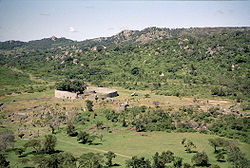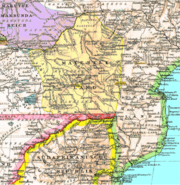
Pre-colonial history of Zimbabwe
Encyclopedia
The pre-colonial history of Zimbabwe lasted until the British government granted colonial status to Southern Rhodesia
in 1923.
 Archaeologists have found Stone-Age implements, Khoisan cave paintings, arrowheads, pottery and pebble tools in several areas of Zimbabwe, a suggestion of human
Archaeologists have found Stone-Age implements, Khoisan cave paintings, arrowheads, pottery and pebble tools in several areas of Zimbabwe, a suggestion of human
habitation for thousands of years, and the ruins of stone buildings provide evidence of more recent civilization. The most impressive of these sites are the Great Zimbabwe
ruins, after which the country is named, located near Masvingo
. Evidence suggests that these stone structures were built between the 9th and 13th centuries AD by indigenous Africans who had established trading contacts with commercial centers on Africa's southeastern coast.
The Mapungubwe
people, a Bantu
-speaking group of migrants from present day South Africa, inhabited the Great Zimbabwe site from about AD 1000 1550, displacing earlier Khoisan people. From about 1100, the fortress took shape, reaching its peak by the fifteenth century. These were the ancestors of the Kalanga and Karanga
people. The Royal Totem was Moyo. Today bearers of the Moyo Totem are found amongst The Kalanga people in Zimbabwe and Botswana as well as the Karanga people in the Masvingo area. According to Prof. Thomas Huffman (chairman of the wits school of Archeology, Geography and Environmental Studies) Kalanga was the language of the Mapungubwe Kingdom which predates the Great Zimbabwe kingdom. He further suggests that the Karanga dialect could have emerged from Kalanga as a result of influence from Zezuru. However other researchers insist that Kalanga is a derivative of Karanga. They believe that Kalanga must have emerged as a result of corruption of the Karanga dialect by invading Ndebele. The later seems less likely if one considers that Kalanga is spoken in areas where the invading Ndebele did not molest. Unadulterated Kalanga is still spoken in Shoshong Botswana were ruins similar to the Great Zimbabwe are found. It is interesting to note that other ruins similar to the Great Zimbabwe are found in Lusvingo, Khami, Dlodlo and other areas were Kalanga is still the language spoken by the communities there.
, Great Zimbabwe and Dhlo-Dhlo. The first major civilization to become established was the Mwene Mutapa (or Monomotapas), who were said to have built Great Zimbabwe, in the ruins of which was found the soapstone bird that features on the Zimbabwean flag. By the mid-1440s, King Mutota's empire included almost all of the Rhodesian (Zimbabwean) plateau and extensive parts of what is now Mozambique
. The wealth of this empire was based on small-scale industries, for example iron smelting, textiles, gold and copper, along with agriculture. The regular inhabitants of the empire's trading towns were the Swahili merchants with whom trade was conducted.
Later they formed the Rozwi Empire
, which continued until the nineteenth century.
 The Matabele
The Matabele
(Ndebele) people in the south arrived in 1834 -- Mzilikazi
fleeing Shaka
.
Southern Rhodesia
Southern Rhodesia was the name of the British colony situated north of the Limpopo River and the Union of South Africa. From its independence in 1965 until its extinction in 1980, it was known as Rhodesia...
in 1923.
Ancient civilization

Human
Humans are the only living species in the Homo genus...
habitation for thousands of years, and the ruins of stone buildings provide evidence of more recent civilization. The most impressive of these sites are the Great Zimbabwe
Great Zimbabwe
Great Zimbabwe is a ruined city that was once the capital of the Kingdom of Zimbabwe, which existed from 1100 to 1450 C.E. during the country’s Late Iron Age. The monument, which first began to be constructed in the 11th century and which continued to be built until the 14th century, spanned an...
ruins, after which the country is named, located near Masvingo
Masvingo
Masvingo is a town in south-eastern Zimbabwe and the capital of Masvingo Province. The town is close to Great Zimbabwe, the national monument from which the country takes its name.- History :...
. Evidence suggests that these stone structures were built between the 9th and 13th centuries AD by indigenous Africans who had established trading contacts with commercial centers on Africa's southeastern coast.
The Mapungubwe
Mapungubwe
After Mapungubwe's fall, it was forgotten until 1932. On New Year's Eve 1932, E. S. J. van Graan, a local farmer and prospector, and his son, a former student of the University of Pretoria, discovered the wealth of artifacts on top of the hill. They reported the find to Professor Leo...
people, a Bantu
Bantu languages
The Bantu languages constitute a traditional sub-branch of the Niger–Congo languages. There are about 250 Bantu languages by the criterion of mutual intelligibility, though the distinction between language and dialect is often unclear, and Ethnologue counts 535 languages...
-speaking group of migrants from present day South Africa, inhabited the Great Zimbabwe site from about AD 1000 1550, displacing earlier Khoisan people. From about 1100, the fortress took shape, reaching its peak by the fifteenth century. These were the ancestors of the Kalanga and Karanga
Karanga
Karanga may refer to:* Karanga , Mangaia, Cook Islands* Karanga , an element of Māori cultural protocol, the calling of visitors onto a marae.* Ikalanga language* "Te Karanga", a song by Rhian Sheehan* a clan of the Shona people...
people. The Royal Totem was Moyo. Today bearers of the Moyo Totem are found amongst The Kalanga people in Zimbabwe and Botswana as well as the Karanga people in the Masvingo area. According to Prof. Thomas Huffman (chairman of the wits school of Archeology, Geography and Environmental Studies) Kalanga was the language of the Mapungubwe Kingdom which predates the Great Zimbabwe kingdom. He further suggests that the Karanga dialect could have emerged from Kalanga as a result of influence from Zezuru. However other researchers insist that Kalanga is a derivative of Karanga. They believe that Kalanga must have emerged as a result of corruption of the Karanga dialect by invading Ndebele. The later seems less likely if one considers that Kalanga is spoken in areas where the invading Ndebele did not molest. Unadulterated Kalanga is still spoken in Shoshong Botswana were ruins similar to the Great Zimbabwe are found. It is interesting to note that other ruins similar to the Great Zimbabwe are found in Lusvingo, Khami, Dlodlo and other areas were Kalanga is still the language spoken by the communities there.
Medieval civilizations
There have been many civilizations in Zimbabwe as is shown by the ancient stone structures at KhamiKhami
Khami is a ruined city located in what is now Zimbabwe. It was once the capital of the Kingdom of Butua of the Torwa dynasty. It is located 22 kilometers west of the modern city of Bulawayo, capital of the province of Matabeleland North. Its ruins are now a national monument in Zimbabwe. Khami is...
, Great Zimbabwe and Dhlo-Dhlo. The first major civilization to become established was the Mwene Mutapa (or Monomotapas), who were said to have built Great Zimbabwe, in the ruins of which was found the soapstone bird that features on the Zimbabwean flag. By the mid-1440s, King Mutota's empire included almost all of the Rhodesian (Zimbabwean) plateau and extensive parts of what is now Mozambique
Mozambique
Mozambique, officially the Republic of Mozambique , is a country in southeastern Africa bordered by the Indian Ocean to the east, Tanzania to the north, Malawi and Zambia to the northwest, Zimbabwe to the west and Swaziland and South Africa to the southwest...
. The wealth of this empire was based on small-scale industries, for example iron smelting, textiles, gold and copper, along with agriculture. The regular inhabitants of the empire's trading towns were the Swahili merchants with whom trade was conducted.
Later they formed the Rozwi Empire
Rozwi Empire
The Rozwi Empire or Lozwi Empire was established on the Zimbabwean Plateau by Changamire Dombo.-History:In 1693, Portuguese militia tried to take control of the gold trade in the interior of sub-saharan Africa by invading the Rozwi empire...
, which continued until the nineteenth century.
Ndebele invasion

Ndebele people (Zimbabwe)
The Ndebele are a branch of the Zulus who split from King Shaka in the early 1820s under the leadership of Mzilikazi, a former general in Shaka's army....
(Ndebele) people in the south arrived in 1834 -- Mzilikazi
Mzilikazi
Mzilikazi , also sometimes called Mosilikatze, was a Southern African king who founded the Matabele kingdom , Matabeleland, in what became Rhodesia and is now Zimbabwe. He was born the son of Matshobana near Mkuze, Zululand and died at Ingama, Matabeleland...
fleeing Shaka
Shaka
Shaka kaSenzangakhona , also known as Shaka Zulu , was the most influential leader of the Zulu Kingdom....
.
See also
- Nehanda NyakasikanaNehanda NyakasikanaNehanda Charwe Nyakasikana was a svikiro, or spirit medium of the Zezuru Shona people. As one of the spiritual leaders of the Shona, she provided inspiration to the Hwata Dynasty for their revolt against the British South Africa Company colonisation of Mashonaland and Matabeleland .She was a Hera...
- MapungubweMapungubweAfter Mapungubwe's fall, it was forgotten until 1932. On New Year's Eve 1932, E. S. J. van Graan, a local farmer and prospector, and his son, a former student of the University of Pretoria, discovered the wealth of artifacts on top of the hill. They reported the find to Professor Leo...
- KhamiKhamiKhami is a ruined city located in what is now Zimbabwe. It was once the capital of the Kingdom of Butua of the Torwa dynasty. It is located 22 kilometers west of the modern city of Bulawayo, capital of the province of Matabeleland North. Its ruins are now a national monument in Zimbabwe. Khami is...
- KalangaKalangaKalanga may refer to:* BaKalanga people* Kalanga language* Kalanga, Togo...
- ikalanaga
- tjiKalanga

